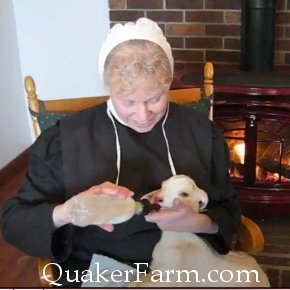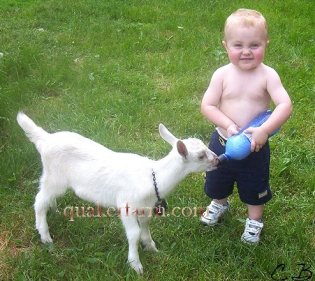Quaker Hill Farm
QuakerFarm.com
How to Bottle Feed a Baby Goat - Part 3
If this site has been helpful to you, please
donate to help support it.
 By Quaker Anne
By Quaker Anne
continued from Part 2
Now that your supplies have been collected, let's consider what to feed a baby goat.
Colostrum
A newborn baby goat needs to consume goat colostrum, preferably from its own mother,
as soon as possible
after birth. This is very important. Colostrum is the first milk. All mammal mothers produce
colostrum for their newborns. It is literally a rich, thick "precious" milk full of
antibodies and
nutrients specific to that mother and newborn, though you can use colostrum from a
different doe, or even sheep or cow
colostrum in a pinch. Colostrum gives newborn babies an important immune
system boost which helps protecting them from infectious organisms. It is a first food that is
so precious and valuable to the newborn, that nothing can replace it. However, time is
of the essence when working with newborns because while colostrum
is rich in vital nutrients and antibodies that newborns need, the ability of a newborn to absorb those
antibodies steadily
and quickly declines. Every hour counts because by about 24 hours after the birth,
the ability of a newborn to absorb the antibodies declines almost completely.
Cold Stress NOTE:
It is best to be accurately aware of due dates so you can be prepared. We try to
attend all births. But, sometimes a doe surprises us and this could happen to you too.
It is important to keep in mind, that if you find a newborn kid that has been cold-stressed,
be sure to warm him/her up before trying to feed. Use a warm water bath (not too warm) if needed
(for about 10 minutes),
then towel dry. Once dried, keep the kid wrapped in a dry towel and put him on
an electric heating pad set on LOW! Do not leave the kid unattended,
and every 10 minutes or so,
literally flip him over to warm the other side. Keep him covered and in a draft-free place.
Once
he has been warmed up, and can hold his head up and begin to cry, bottle
feed him warm colostrum from his mother. The results of this procedure
can look miraculous. Once warm
and warmly fed, kids usually quickly and completely recover from being
cold-stressed after birth.
Real Milk versus Milk Replacer
Never, use milk replacer made with
soy protein. Newborn animals can not digest soy protein. Because of this, they can starve
to death
on a full stomach. If milk replacer must be used,
use only the very best quality powdered goat milk replacer. It is made with milk
and you should have good success using it. Also, try to find someone in your area who raises
goats and ask to purchase a pint of colostrum which you can
freeze. One method that works well is to fresh freeze colostrum in little recycled
yogurt cups, 2 to 3 ounces per cup. This way, you have this precious
food for an initial first feeding then perhaps a bit more to mix
with powdered lamb milk replacer, if you don't have a doe to get milk from.
This provides a good start for a baby goat.
So, how do we teach a newborn goat to drink from a bottle?
First, place a
clean bath towel over your lap. I place a goat kid on my lap with his rear legs draped over the left side
of my lap and front legs draped over the right. The kid is then held securely (see photo above)
and is easily prevented from struggling.
Now, place your left hand under the kid's chin and introduce the bottle.
If the kid is warm and content, he will be hungry. With loving persistence and gentle
encouragement the baby will master the knack of being bottle fed fairly easily.
If a goat kid is a day or two old and has already nursed on
his mother, it may take a bit longer to make the adjustment to a nipple.
The most difficult part for a goat kid during this learning process is the unfamiliarity
of a rubber object being inserted
into its mouth. Artificial nipples have an unpleasant taste and texture being synthetic.
Understanding this will help you
to be more gentle about the process of adjustment.
Now, gently stroke his muzzle to encourage him to relax and to initiate the
sucking reflex. This is a comforting
exercise which helps the infant focus on the task at hand.
Once the goat kid accepts the nipple, continue to maintain support under his chin until he finishes the
contents of the bottle.
 Goat Kid Feeding Schedule
Goat Kid Feeding Schedule
Day 1 to day 5
3 to 4 ounces colostrum, every 2 hours
Day 2 to day 7
4 to 6 ounces every 3 hours
Week 2 through week 4
6 - 10 ounces 4 times a day.
Access to grain, hay, water and loose mineral salt (with selenium) and pasture from now on.
Week 5 through week 10
10 to 20 ounces 3 times a day
Months 3 - 7 20 to 30 ounces 2 times a day. Kids are weaned at around
7 months depending on rate of gain,
over all body condition and of course, the weather and time of year!
Frequent, moderate, regular feedings are best for bottle fed goat kids.
|